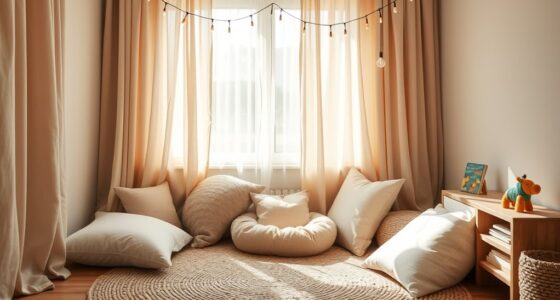To design a minimalist playroom on any budget, focus on multi-purpose furniture like storage benches and open shelves to keep clutter minimal. Choose calming, neutral colors for walls and decor, adding small accents for personality. Use simple storage solutions such as baskets and repurposed containers to stay organized and cost-effective. Keep decorative elements minimal to maintain a peaceful vibe. Continue exploring easy, budget-friendly ideas to create a functional and inspiring space for your little one.
Key Takeaways
- Use multi-purpose furniture like storage benches and open shelving to maximize space and keep clutter minimal.
- Choose a calming, neutral color palette with subtle accent colors to create a peaceful environment.
- Incorporate budget-friendly storage solutions such as baskets, bins, and repurposed household items.
- Keep decor simple with minimal decorative elements that complement the room’s calm aesthetic.
- Maintain an organized, purposeful layout that encourages exploration and supports a minimalist, relaxing vibe.

Creating a minimalist playroom is about more than just reducing clutter—it’s about designing a space that encourages creativity and calm. To achieve this, you need to focus on effective storage solutions that keep toys and supplies organized without overwhelming the room. Opt for sleek, multi-purpose furniture like storage benches or low shelves that hide clutter while providing easy access. Baskets, bins, and wall-mounted organizers can further contain smaller items and make tidying up quick and simple. The goal is to create a sense of order that invites your child to play freely, without the distraction of chaos.
Effective storage solutions create a calm, organized playroom that invites creativity and free play.
Color palettes play a *pivotal* role in establishing a calm, inviting atmosphere. Stick to a neutral or muted color scheme, such as soft grays, whites, or pastel shades, to foster a tranquil environment. Incorporate a few accent colors sparingly to add visual interest without overwhelming the space. Light, natural tones reflect sunlight and make the room feel more open, which is essential in maintaining a minimalist aesthetic. Keep in mind that a consistent color palette enhances the feeling of harmony and helps the room look thoughtfully curated, even on a limited budget. Additionally, choosing color-accurate paint and decor ensures the space maintains its intended calming effect over time.
When choosing storage solutions, prioritize simplicity and function. Open shelving can display select toys or books, making it easier for your child to find and put away items. Closed cabinets or drawers hide clutter behind clean facades, maintaining the streamlined look. Use clear containers or labels to encourage independence and organization. If you’re on a tight budget, repurposing items like cardboard boxes or repainted furniture can serve as cost-effective storage options. Remember, the key is to keep everything purposeful and uncluttered, so each storage piece contributes to the overall minimalist vibe.
In terms of color, avoid overly bright or busy patterns that can distract or overstimulate. Instead, choose a cohesive color palette that promotes relaxation and focus. You can add personality with simple decorative elements like a few framed prints or a small, colorful rug that complements your chosen color scheme. These touches add warmth and character without disrupting the room’s simplicity. Combining thoughtful storage solutions with a harmonious color palette creates a playroom that is functional, peaceful, and inspiring—regardless of your budget. The result is a space where your child can explore, learn, and grow in an environment that feels calm and organized.
Frequently Asked Questions
How Can I Incorporate Educational Elements Into a Minimalist Playroom?
You can incorporate educational elements by choosing simple, versatile educational toys that promote creative learning. Opt for open-ended toys like building blocks or art supplies that encourage exploration. Keep the space uncluttered by selecting a few key items, and display them neatly to inspire curiosity. Incorporate subtle educational posters or books on shelves for easy access. This approach fosters learning while maintaining a minimalist, calming environment.
What Safety Features Are Essential in a Minimalist Playroom Design?
You should prioritize safety by using secure toy storage to prevent tripping hazards and keep clutter out of the way. Incorporate soft furnishings like cushioned mats and padded furniture to protect your child during play. Guarantee all furniture has rounded edges, and anchor heavy items to the wall. Regularly check for small parts or damaged items, creating a safe, clutter-free environment that encourages exploration without risks.
How Do I Maintain Minimalism as My Child Grows Older?
As your child’s needs grow, think of minimalism as a flowing river, constantly adapting. You keep clutter at bay by choosing clever storage solutions that grow with them, like modular shelves or multi-purpose furniture. Regular decor updates help keep the space fresh without chaos. Stay intentional, removing excess as interests change, so your playroom remains a calm, inspiring oasis that evolves seamlessly with your child’s journey.
Are There Eco-Friendly or Sustainable Options for Playroom Materials?
You can choose eco-friendly options like recycled plastics for storage bins and toys, which reduce waste and are durable. Organic fabrics are perfect for cushions, rugs, and curtains, providing a safe, non-toxic environment for your child. These sustainable choices help you create a minimalist, eco-conscious playroom that’s both functional and gentle on the planet, ensuring your child’s space is safe and environmentally friendly.
How Can I Personalize a Minimalist Playroom Without Clutter?
Think of your playroom as a garden—personal touches are the colorful blooms. To personalize without clutter, choose sleek storage solutions that hide toys and supplies, keeping surfaces clean. Add decorative accents like playful rugs or artwork that reflect your child’s personality. These thoughtful details make the space uniquely theirs without overwhelming the minimalist aesthetic, creating a harmonious environment where personality blossoms amidst simplicity.
Conclusion
So, you’ve created a clutter-free, minimalist playroom—pretty ironic, isn’t it? All that simplicity, and now your little one has fewer toys to trip over. But hey, maybe that’s the point: less mess, less stress, more room for imagination. Who knew that cutting back could make playtime feel so expansive? Sometimes, the simplest space sparks the biggest adventures. So enjoy the calm—until the next toy avalanche, of course.










